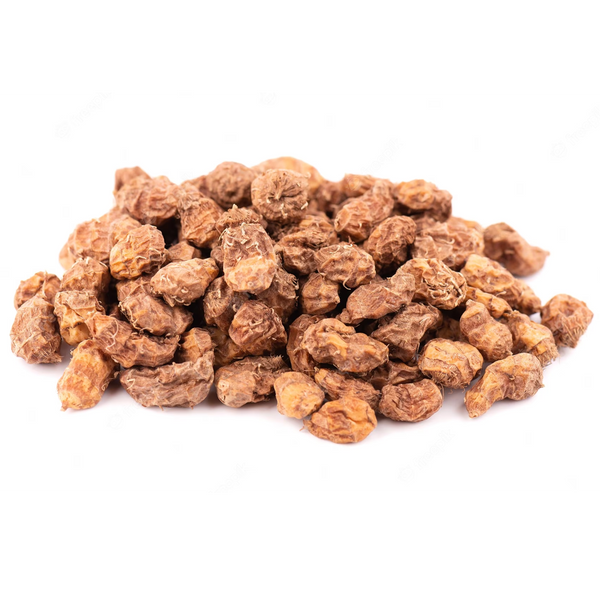Perennial plant (in culture it is grown as an annual) 30-90 cm tall. The color of the tubers is from light to dark brown with a yellowish or pink tint. There are 3-6 transverse grooves on the surface. The flesh is white, sweetish to the taste, the consistency is firm, crispy. Chufa (Cyperus esculentus), ground almond, perennial tuberous plant of the sedge family. The general area of distribution of chufa covers the Mediterranean countries, South Africa, Asia Minor, India and North America up to 55o north latitude), it is also distributed in tropical Africa. In a wild state, Chufa grows in Transcaucasia and in places in Central Asia. North Africa (Nile River Valley) is considered the homeland of Chufa. This culture has been cultivated since 1993 at the station of young naturalists in the collection department of the NDZD. Outwardly, chufa resembles a wild sedge. The bush of the plant reaches 50-80 centimeters in height (it all depends on the nutrition of the soil on which it grows) and consists of narrow, hard leaves collected in bunches. On the rhizomes of plants, tuber-nuts are formed, there can be up to 400 of them on one bush. Chufa tuber-nuts are oval or round in shape, from 1 to 3 cm long, covered with a light brownish skin that does not separate from the pulp, which has a whitish creamy color and sweet taste. In Ukraine, the plant became known from the middle of the 18th century, but it did not become widespread. The first scientific data on Chufa research appeared in the 1930s. Today, Spain is the only country that is the main supplier of chufa to the world market, as it uses the technology of mechanized cultivation and harvesting of this crop. This technology of mechanized harvesting of chufa has been introduced in Canada and Bulgaria. Today, this crop remains an agricultural crop with high technological labor costs and, for this reason, has not been widely adopted in crop production. In most private farms, chufa is currently grown in small volumes, as the care and collection of tubers is done manually. Chufa is a perennial herb that reaches 1 m in height. The terrestrial part is green narrow arrow-shaped leaves with three-sided shoots. At the very top of the plant there are small inflorescences of small white flowers that resemble umbrellas. The underground part is the main kidney of the tuber (greens grow from it) and side tubers (shoots of a powerful root system emerge from them). The plant is pollinated by the wind. Under good conditions, the chufa nut only forms tubers in the first year, but does not bloom. Up to 1,000 good tubers are collected from one plant per year, which can be described as follows: length - up to 3 cm; oval shape; the inner flesh is white; when drying, the tuber becomes wrinkled. Chufa nuts are not only tasty, but also very useful for health: they have antioxidant properties that strengthen the immune system, improve memory and attention, lower blood sugar, improve skin condition, normalize the work of the gastrointestinal tract tract It is believed that chufa helps restore strength and tones very well, as well as removes radionuclides. Chufa - ground almonds are a valuable food concentrate that contains up to 60% of substances useful for the human body, of which 30% are fats, 28% sugars, 10% proteins and 1.3% starch. From the nuts (bubbles), Chufas make flour, which is added in the production of halva, candies, and other confectionery products. Puffs fried in a pan or in the oven are in no way inferior in taste to hazelnuts or almonds. Chopped and roasted chufa nuts are added to salads, which gives them a certain piquant taste. In Spain, especially in Valencia, a cool drink called orshad (horchata) is popular. It is prepared from soaked bulbo-peanuts, which are ground in a blender, on a meat grinder or in a marble mortar and poured with boiling water. Then filter through a fine sieve. In this way filtered "almond milk" add sugar, vanilla, cinnamon to taste and cool. A drink that replaces coffee is also prepared from well-roasted chufa. Anyone who dares to grow chufu has the opportunity to enjoy home-cooked meals with the addition of these wonderful earthy tubers. The leaves of the plant are fed to livestock. It is even prepared for the winter, having previously dried well. Crushed tubers are also not thrown away, they are well eaten by birds. Other areas of application: the stems were used to weave very beautiful and strong baskets; paper, fuel, insulating material and ropes are made from leaves; this plant has found application even in cosmetology - it is added to shampoo and toilet soap; fishermen use tubers as bait.

